How Far Can Zagreb Grič Cannon Fire? Ideal Conditions View of the Fire Range
July 21, 2021 - Ever wondered about the Zagreb Grič Cannon fire? TCN reporter Ivor Kruljac played with Google maps to provide an answer in ideal conditions.
While Zagreb Grič Cannon did not shoot at the time of writing this article, it is still one of the key symbols of Zagreb, and memories of its bang during midday is a vital part of the living in Zagreb experience.
As TCN previously wrote, the Grič Cannon was first introduced on January 1, 1877, and was located at the State's Meteorology department, back in the times when Croatia was part of the Austro-Hungarian Monarchy. It wasn't until 1927 that it was moved to Lotršćak, where it is situated to this day. In addition, the current cannon serving this purpose is actually the fifth to do the job and was donated to Zagreb by the Yugoslavian National Army (JNA), during Universiade.
Apart from signaling noon, the old legend says the Grič Cannon also served a defensive purpose. As TCN previously wrote, legend has it that the Ottoman commander Hasan Pasha (Hasan Paša) settled his army along the coast of the Sava river, in today's area of Novi Zagreb. He was preparing to cross the river and invade the city, but before that, he was about to have lunch, and Zagreb fired a cannon in the Ottomans' direction, close to Hasan, blasting a chicken he wanted to eat. The shot scared the hell out of the Ottomans, and they retreated, leaving Zagreb totally intact.
The legend itself is part of a book titled ''The Grič Cannon legend'' in which writer Dubravko Horvatić has gathered 20 Croatian legends, and the book is a mandatory book report title for Croatian pupils in the third year of elementary school.
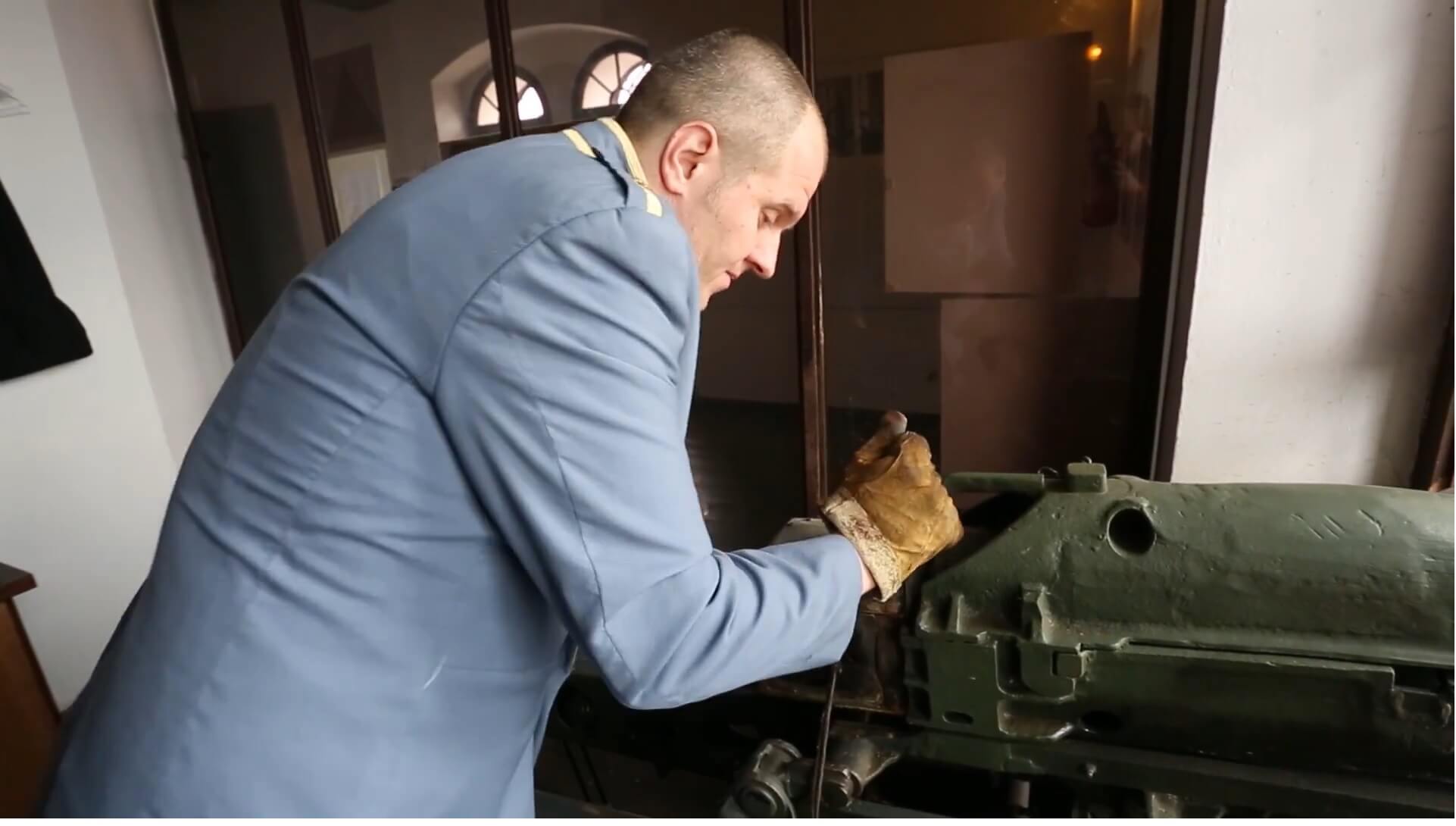 Preparing the cannon, screenshot / PIXSELL
Preparing the cannon, screenshot / PIXSELL
Legend vs facts
With the story taking place way back in the 16th century, it's obvious the tale is just a legend as the cannon wasn't introduced until the 19th century. Still, it's a cool story, and a bit of a twisted mind can't but help think: what's the range you could actually shoot with the Grič Cannon?
As the Wikipedia page says, and as a member of the Zagreb Tourist Board in Lotrščak tower confirmed to this sleuth reporter, the current cannon's range is 7,929 metres (almost eight kilometres), and the sound of the blast has a solid 140 dB.
Legend says Hasan Paša was on the coast of the Sava river, which means he was in southern Zagreb, and sure enough, the Grič cannon is facing south from Lotrščak. The cannon floor also has windows looking in each direction, meaning you could move the cannon to north, west, or east.
When playing with Google maps distance measuring tools, you can see that the smallest distance between the Sava river and Lotrščak is, give or take, about 3,1 kilometres. So, the current cannon, under the right angle, could easily make that shot.

The distance between Fort Lotrščak and Sava river, screenshot / Google Maps
Apart from the possibilities of buildings and hills messing up the shot, there are other things that need to be taken into consideration. As the Department of the Army U.S. Marine Corps identified back in 1996, in their manual, there are many factors that affect artillery fire.
Muzzle velocity, projectile weight, range wind, air temperature, air density, even the rotation of the Earth, not to mention the overall condition of the barrel, all of which are challenges that could limit the cannon's full potential. And yes, Google maps isn't really the most precise tool on the planet, but let's take a shot in the dark and see how far the Grič cannon could actually fire (keep in mind these projections are made solely based on the maximum range, and the factors aren't taken in account but are mentioned for the sake of trivia knowledge).
South! Aim! Fire!
Let's start from the cannon's current position. Assuming no buildings, hills, or anything else gets in the way, and you're a physics genius that managed to isolate yourself in Lotrščak with live ammo and achieve a clear straight shot, your cannonball makes an impact all the way in line with Donji Čehi (but a bit away to the east from that place). Donji Čehi, along with Gornji Čehi, used to be independent villages but are today part of the City of Zagreb. With only 1,72 km2 of length, the place is inhabited by 232 residents, based on a 2011 census.

Grič Cannon maximum range to the south, screenshot / Google Maps
West! Aim! Fire
Continue clockwise and set your cannon to take a shot towards the west, with a range of little under eight kilometres. You can score all the way to Krnska street in Gajnice. Krn is both a name of a mountain and a peak (2244) in neighbouring Slovenia. The mountain is a part of the Triglav National Park in Slovenia (and if this side note makes your attention turn to Slovenia, be sure to check our friends at Total Slovenia News). Gajnice is a neighbourhood in Zagreb that is inhabited by around 10,000 residents. The neighbourhood is notorious for its pretty lousy connection with the rest of the Zagreb, and local residents often complain about infrequent buses that connect them to Črnomerec from where they can travel to the city centre. Well, at least, the centre doesn't aim at them with a cannon.

Grič Cannon maximum range to the west, screenshot / Google Maps
North! Aim! Fire!
The new target, or perhaps better to say lucky shot, lies towards the north. Don't worry about Medvednica mountain getting in the way of a clear shot towards Zagorje, as the range isn't long enough. The shot will hit Medvednica mountain, more precisely, to the close proximity of Tusti Vrh. This location is 648 metres above sea level and serves as a stand for a communication station with some antenna polls. But, there's no need to shoot the place up and destroy a lovely piece of nature, which also serves as an important social role in regards to telecommunication. Instead, you can visit the place as the Gračani trail leads there.

Grič Cannon maximum range to the north, screenshot / Google Maps
East! Aim! Fire!
Finally, it's time to ruin someone's day in east Zagreb (fortunately, no person was hurt during these simulations in reality). Specifically, this applies to whoever lives in Retkovec III near Bruma Interijeri d.o.o., a company specialised in woodwork.
Petkovic is a neighbourhood that is part of the Dubrava district. It's mostly a residential place, like much of eastern neighbourhoods considered to be a bit of a rough area to live in. Still, things aren't as bad as they were as before.

Grič Cannon maximum range to the east, screenshot / Google Maps
Shooting blanks
Again, it's worth noting these projections aren't accurate science and imply conditions which are perfect. Of course, in an ideal world we wouldn't need firearms and everyone would be living in peace. In reality, where these ideal conditions don't apply, residents of the aforementioned areas, but also citizens in general, can be relaxed, as the ranges are irrelevant.
 Shots fired aftermath, screenshot / PIXSELL
Shots fired aftermath, screenshot / PIXSELL
''It's worth noting the cannon is modified, and it can't fire live ammo,'' warned the Zagreb TB official, who was a bit puzzled as to why I would even ask her for the potential range of a weapon overlooking the Croatian capital from Fort Lotrščak. But, as I'm sure any researcher will confirm, scientific curiosity often calls for asking controversial questions.
Learn more about Zagreb on our TC page.
For more about history in Croatia, follow TCN's dedicated page.
Zagreb Grič Cannon: Explosive Noon Reminder
July 9, 2021 - Zagreb Grič Cannon - a reminder of noon, and a reason to avoid the centre if you aren't a fan of loud sounds. Get your noise-canceling headphones and read about the cannon's history, courtesy of TCN reporter Ivor Kruljac.
If you find yourself walking around a wider Zagreb centre (such as Savska Cesta or Marin Držić Avenue) around noon, and you focus on the sounds of the city, you may notice a weird sound in between traffic and people passing. An unusual sound, as if someone dropped a heavy box. But, if around noon, you find yourself at Ban Jelačić square or upper town, you will hear a clear and loud BANG! Fear not, as this is not a terrorist attack, and you weren't lied to when your tourist agency swore to god Zagreb is safe from such horrors. The heart-stopping bang is a signifier of noon. If you hear a boom at 11:59 or 12:01, your watch is behind a minute. The cannon states that clear and very, very loud.
Loudest time checker you could think of
Grič cannon first started signaling noon on January 1, 1877, and was located at the State's Meteorology department, back in times when Croatia was part of the Austrian-Hungarian Monarchy. It wasn't until 1927 that it was moved to Fort Lotršćak where it is situated today.
According to the Klovićevi Dvori Gallery's official website, Fort Lotrščak was named after a bell and comes from campana latrunculorum, which is Latin for „Bell of Thieves“ that rang before closing city gates. Historians aren't exactly sure what the Fort looked like in medieval times, although it is speculated based on old sketches that it had only two floors. It wasn't until 1857 that romanticistic architecture gave the fortress today's four floors and an additional tower at the very top (from which you have a breath-taking view of Zagreb today).

Fort Lotrščak © Ivor Kruljac / Total Croatia News
In the 17th century, the Fort served as trading storage and had various other ways to adapt to the need of Zagreb and Zagreb's citizens at different times. At one point, when the City was out of money to restore and repair the Fort, it gave Lotrščak to citizens for rent. Citizens who wanted the Fort also had the obligation of maintaining it, and in case of enemy assault, it was to be returned back to the City for defense purposes.
Warning shot
Speaking of defense purposes, an old legend says how this cannon managed to save Zagreb with a single shot from the Ottoman conquerors. Legend has it that the Ottoman commander Hasan Pasha (Hasan Paša) settled his army at the coast of the Sava river, in today's area of Novi Zagreb. He was preparing to cross the river and invade the city. But before that, he was about to have lunch one day, and Zagreb fired from the cannon in the Ottoman's direction, close to Hasan and blasting a chicken he wanted to eat. The shot scared the hell out of the Ottomans and they retreated, leaving Zagreb intact.
Changing arsenal
Over the course of time, there were five different Grič cannons that served the purpose of signaling noon. The current canon was given during Zagreb's Univerzijada in 1987, courtesy of the Yugoslavian National Army (JNA) as Croatia at the time was part of the Socialist Federal Republic of Yugoslavia (SFRJ).
As for the first three, you can find them today in the collection of the Zagreb City Museum. The first cannon originated in 1876 and was replaced by the second cannon in the unidentified year at the end of the 19th century. The third cannon you can see in Zagreb City Museum, and the first that was situated on Lotrščak fort, was introduced in 1928, and it was made by restoring a Polish cannon from 1912.
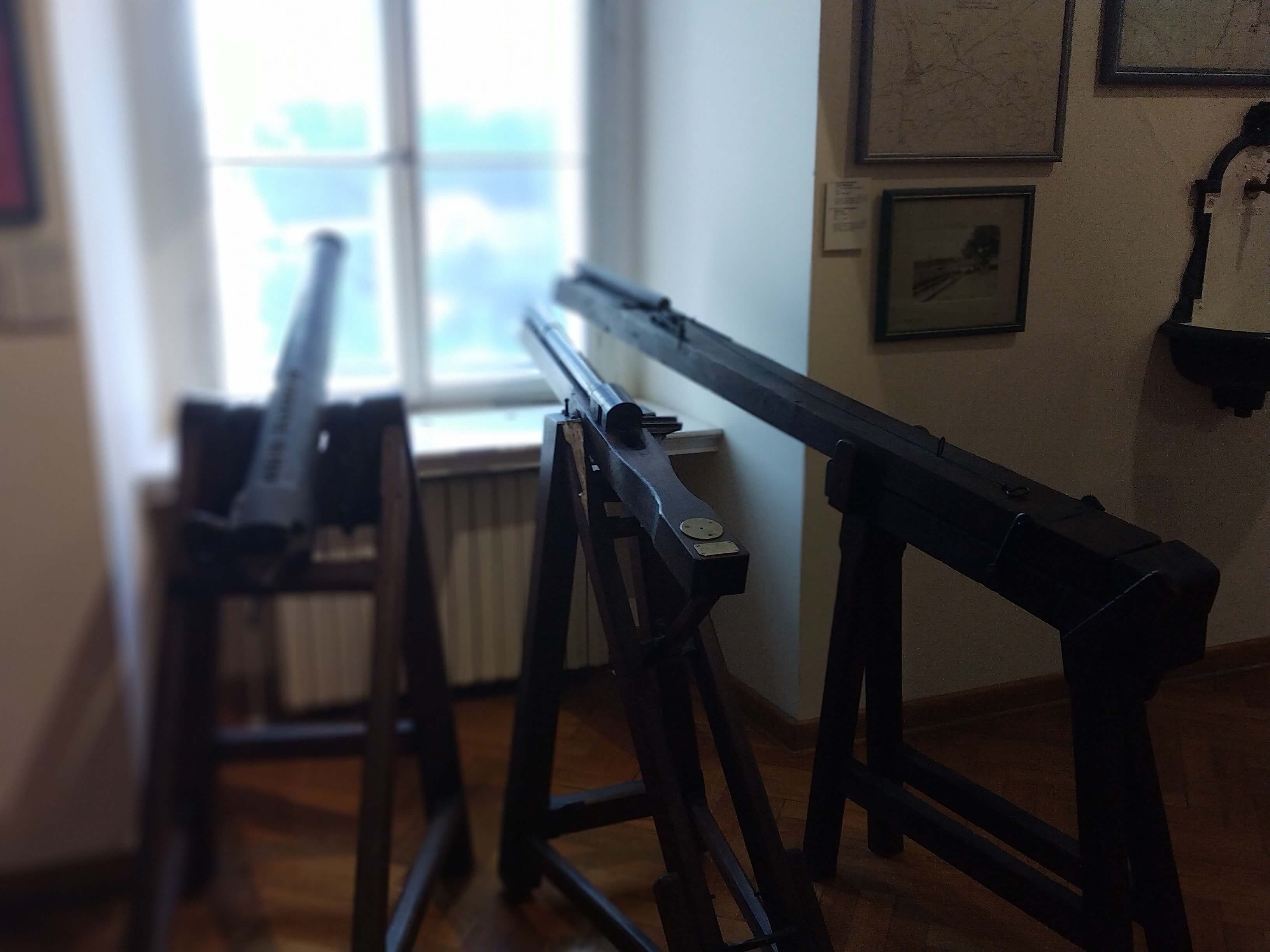
Three cannons showcased at Zagreb City Museum © Ivor Kruljac / Total Croatia News
So finding yourself in front of Fort Lotrščak (whose entrance is located right next to the Upper town funicular station) is not recognizable if you are not a fan of loud noise as it can give you a sound fright even down below at Jelačić square and the surrounding area. But, for the brave ones, the Grič cannon can provide a unique souvenir from Zagreb. It doesn't use live ammo (the cannon is modified so it can't), but it does fire several pieces of thick cardboard that then flies down to the area underneath Lotrščak's entrance and smelling like gunpowder.
Ceased fire
Despite being a regular background sound for the experience of living in Zagreb, Grič cannon went through periods when it ceased fire and stopped making statements. The first such instance was World War I and then followed by the war in the nineties. Most recently, the cannon was silenced after the Zagreb earthquake on March 22, 2020, but it re-fired hot and heavy sometimes in May 2020. However, followed by the December 29th Petrinja earthquake, which was also felt heavy in Zagreb, the cannon is silent even today.
„We are not quite sure when it will re-fire“, briefly commented the Zagreb Tourist Board member that welcomed me in Fort Lotrščak, one of the locations where Zagreb TB has a regular stand. Still, despite the cannon being silenced, you can climb and sightsee Lotrščak, the famous cannon as well as the watchtower on top of the Fort, for the prize of 20 kunas.

One of the exhibitions at Lotrščak © Kula Lotrščak
The Lotrščak Fort address is Tomićeva 9, and the Fort occasionally also hosts various exhibitions at times too. But, the cannon is a regular feature, and there are lots of info on the history of the cannon and the Fort itself there too on the walls- both in English and Croatian.
Learn more about Zagreb on our TC page.
For more about history in Croatia, follow TCN's dedicated page.
Maritime Welfare in Croatia: Drvenik Case and What Law Says
June 25, 2021 - The issue of maritime welfare in Croatia was raised once again after a heated discussion on a beach in Drvenik Veli. Here are the details of the case and legal guidance to the maritime welfare in Croatia.
With the 2021 tourist season already being 58% better than 2020, tourists once again visit Croatia as one of the top holiday destinations.
However, like any year, the season can't go without at least some sort of incident.
Lovely beach, disgusting words
Yesterday, Croatia was shocked and enraged with the incident that happened on a beach on Drvenik Veli island (not so far from Trogir). Croatian journalist Tonka Alujević and her friend went to a beach where two Czech tourists started complaining that it's a private beach, perks of paying for a villa, and that Alujević needs to leave. Alujević refused to leave, stating that beaches are maritime welfare and cannot be privatized, refusing to move. After, as Alujević claims Czech tourists hit her head with a phone, they called the villa owner. 24 Sata daily newspaper published a video Alujević's friend recorded.
„Ma'ams, Ma'ams, how did you get here? On foot?“, asked the owner on a phone that was on speaker and held by the Czech tourists.
„I'm a journalist. Do you know Croatian laws? Do you want to end up in media?“ replied Alujević with a chill face while smoking a cigarette on a sunny day at the beach.
„Come on, put me in the media, come on put me! But first, go to the land register and see that my beach is private," screamed the owner in Croatian, with a lot of derogatory phrases (if only Czech tourists had a translator to understand the rich swear word heritage of Croatian language, right?)
The whole thing ended up with inspection stepping on the scene. Despite the video footage being clear, the owner, identified by Index.hr as Tomislav Meštrović, owner of Centovi Dvori Villa, tried to justify himself, saying everyone is welcomed at the beach, and he attacked the women because they passed through his doorway.
„No, I have no idea what video, who what... who knows what that is... I called the police for trespassing through my land“, said Meštrović to Index.hr when asked about the footage.

the conversation at the beach, screenshot/ 24sata
Law and order
Following this story, Index.hr's columnist Goran Vojković analyzed the law to clear up the issue of maritime welfare.
„The Maritime Welfare and Sea Ports Law states 'at least six meters from a line horizontally distant from the line middle waters'. But it can be wider, for example, if part of the land that in its nature or use serves to exploit the sea. It can also be narrowed- for instance, if support walls or a public road are close to the sea“, Vojković listed general rules but adding that maritime welfare border is specifically determined.
„So, the coast is free to use where the beach is, in general, six meters. You can come and use it for your needs, such as bathing, tanning, or walking. The land behind can be private, but the coast cannot“, concluded Vojković.
On the other hand, there are ways to limit the use of maritime welfare.
„There are some parts of the coast where you cannot enter. You can enter the marina and walk around it, but only until 10 pm. You cannot enter at all in a shipyard port. Those are the parts of maritime welfare for which the state assigned a concession to someone. The concession can limit or terminate public use“, explained Vojković.
Additionally, the law states that it is possible to have a beach in its concession and limit public entrance. But it needs to be registered, and the prices are so expensive that there are very few beaches like this in Croatia (Drvenik one not included in that small list).
„If someone claims that has a concession and that he/she can exclusively use some part of the coast, he needs to have a proof you can easily check in the register. I repeat, there are very small examples; even beaches in front of five-star hotels are public good“, Vojković pointed out.
And such beaches are filled with deck chairs, food stands, etc. But as Vojković pointed out, on a public beach, you have the right to bring your own deck chair, your own food, and drinks, and you can't be forced to consume content on the beach.
„In short, enjoy the Adriatic coast- with some very small exceptions of exclusive concessions, the entire coastline (including island coast) is free for your use and joy. Nobody can hold a grudge or complain if you came to a bath where they think it's 'their' beach. If someone is uncomfortable, don't debate, call authorities“, advises Vojković.

Pixabay
And the beach is open for public happily ever after
As Jutarnji List reported, the Drvenik case has a conclusion to an intriguing plot. Unhappy with Meštrović's behavior, Dalmatian locals went vigilantly and started writing bad reviews on Google, seeing the villa losing its value and tourists.
„Even though neither the building, nor its surroundings changed since the video was released, the unkindness of the owner was enough to move once-prestigious villa to the lowest grading Croatian places on Google“, says Jutarnji.
A couple of more lessons can be learned for a successful and enjoyable season from this tale.
For owners: present your offer fair in accordance with the law as transparency is the best way for your offer to beat the competition.
For tourists: if you were promised a private beach, but you see locals coming, don't be rude to them and don't attack them. The only one you can really be mad at is your host, who perhaps lied about what they can truly provide.
Learn more about beaches in Croatia on our TC page.
For more about travel in Croatia, follow TCN's dedicated page.
Croatian Mountain Rescue Service Book Presented by Ivo Pilar Social Research Institute in Gospić
May 16, 2021 - Suitable for the 30th anniversary of one beloved Croatian civil protection organisation, the Croatian Mountain Rescue Service book was presented by the Ivo Pilar Social Research Institute based in Gospic.
With many tourists and visitors (and Croats too), not being too careful when going on ''their little adventures'' up mountains such as the Dinara, Velebit, or elsewhere, the Croatian Mountain Rescue Service (HGSS) is as busy as Batman in Gotham. What with saving people who get lost, being bitten by poisonous animals that live on the mountains, or dealing with people who have hurt themselves in any way, they truly are praised as superheroes and are often the most beloved people on Croatian TV, either in commercials or when the press, telling their heroic tales.
Apart from mountains, their training was also shown to be useful for easing the numerous issues left following the 2020 earthquakes too.
Marking the 30 year anniversary of HGSS's station in Gospić, the Gospić Culture And Information Centre saw the presentation of the book ''The Day Replaced the Night, The Bura Wind Cleared Our View“ (Dan Je Zamijenio Noć, Bura Nam Očistila Pogled), last Friday. As reported by the Ivo Pilar Social Research Institute website, the authors of this pop-science monograph are dr. Ivan Brlic, dr. Nikola Simunic and Dr. Anita Busljeta Tonkovic.
''The Gospic HGSS station, even though with a relatively small member count, operates on the biggest and toughest rescue surfaces in all of the Republic of Croatia. This monograph, through geographical, historical and sociological context, aims to explain how important, but also how difficult the mountain rescuer's job is. The Croatian Mountain Rescue Service book, covering over 150 pages in an honest and interesting way, shows why HGSS is one of the cornerstone operative forces of civil protection and that, in its professional, altruistic, and humane approach, contributes to the overall civil rescue system with the goal of saving human lives,'' they stated from the Ivo Pilar Social Research Institute.
Apart from the authors of the Croatian Mountain Rescue Service book themselves, the event saw HGSS Croatia's main man, Josip Granic, the director of the HGSS Gospic station, Josip Bozicevic, Deputy Interior Minister Damir Trust, as well as the Ivo Pilar Social Research Institute Headmaster, Dr. Zeljko Holjevac sit down and speak. All of them agreed that this book is an important statement of gratefulness to HGSS members for all of the hard work they do.
The book is a product of the Ivo Pilar Institute's successful collaboration with the institutions in Gospic, and the wish for the further and deeper continuation of that cooperation was expressed too. In case of need, HGSS can be reached by calling 112. But, to prevent becoming yet another damsel (or a bachelor) in distress, it's not a bad idea to check their safety guidelines for enjoying the outdoors in Croatia.
Not to far from Gospic is the North Velebit National Park with its glorious mountains, about which you can learn more on our TC page.
For more about the Ivo Pilar Social research Institute in Croatia, follow TCN's dedicated page.
10 Things Croatians Do That Tourists Find Weird
June 15th, 2021 - As the summer season begins and the country is welcoming a large number of tourists, it's time to take a look at 10 things Croatians do that tourists may find weird on their visit here.
1. Our coffee culture
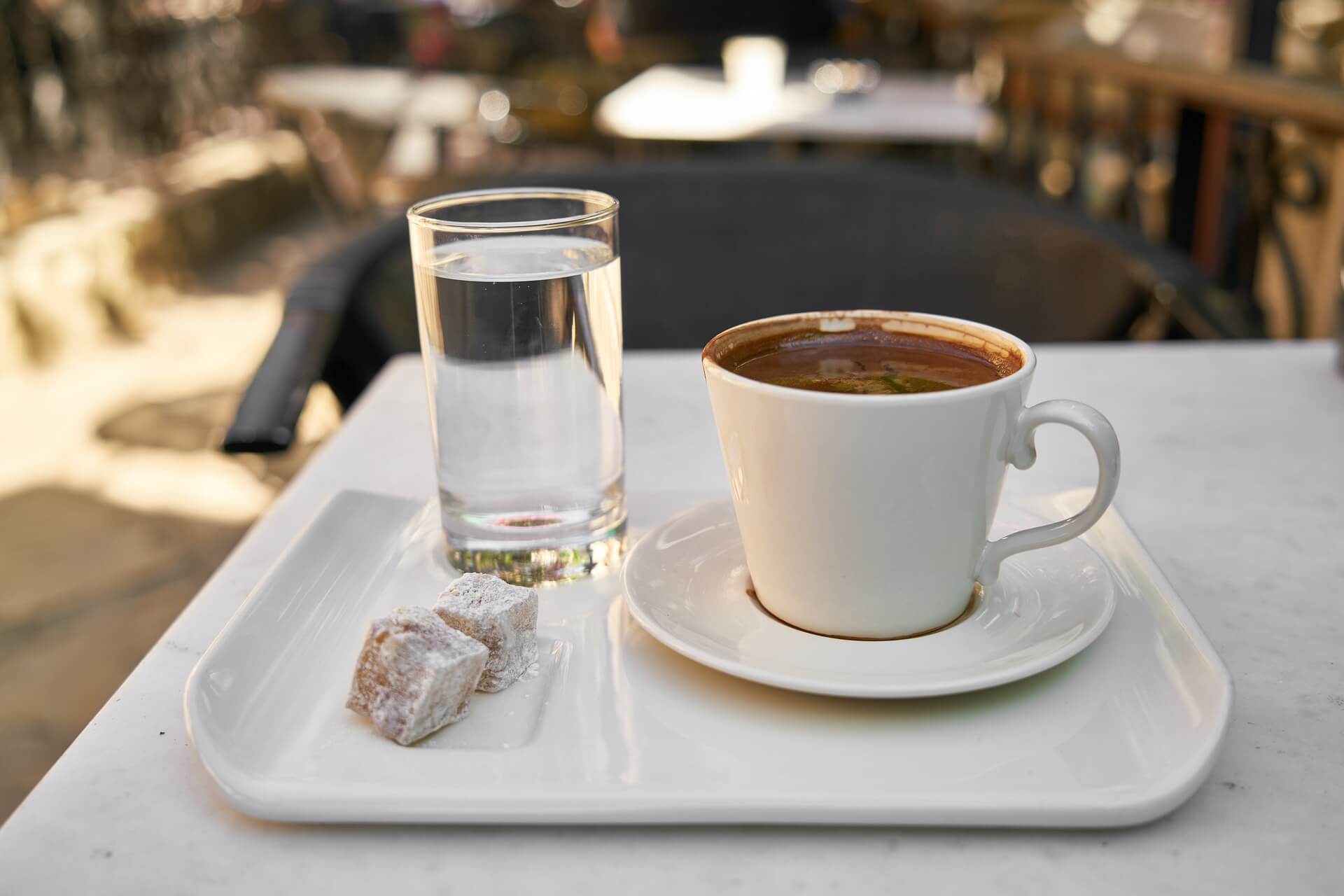
Pixabay
Croatians love drinking coffee and taking their time, and we tend to take our coffee culture very seriously. At home, we make Turkish coffee, and outside we drink Italian, simple as that. We like our coffees very strong and mostly black, nothing fancy. The only acceptable additions are milk and sugar, no fancy sweeteners or syrups allowed in Croatian households. Another thing about our coffee culture is that we take our time and sip it slowly. It can take hours to get through one cup of coffee because we are in no rush. Drinking coffee in Croatia is a carefree and relaxed part of our culture that we embrace daily.
2. Rakija fixes everything
Rakija is considered to be the magic fix for any trouble in Croatia. Do you have a sore throat? Take a shot. Did someone break your heart? Take a shot. Do you have a fever? Maybe don't take a shot, but you should soak a towel in Rakija and put it on your head. Did you hurt yourself? Have a shot and disinfect the wound with Rakija. It is an all-around problem solver in Croatia.
3. Family comes first
In Croatia, there is nothing more important than family. It's normal for children to leave the nest very late and live with their parents until they get married. Most people also stay in their hometown, so they see no point in moving out. It's just how things have always been here, and family is number one always. At home, you are known because of your parents, and your name determines your value and social status. In Croatia, it's very common to be asked "who are your parents," especially in small towns because people really do know everyone.
4. Cooking with Vegeta

Podravka Facebook
If you enter any Croatian household and don't have Vegeta, are you really in a Croatian household? Vegeta is a vegetable seasoning used daily in any Croatian kitchen and on everything you can think of. It simply is an all-purpose seasoning that is a staple in any Croatian household.
5. Seafood Fridays
Seafood on Fridays is very popular in Croatia because of our religion, so you'll notice that most restaurants have some seafood specials every Friday. Most people follow it even if they aren't religious, and in a Croatian household, you cannot and should not be eating meat on Fridays. It mostly consists of fish, but it's considered acceptable for as long as it's from the sea.
6. Propuh
If you're from Croatia or have been to any Croatian household, you're aware that propuh is pretty much illegal. Propuh is a wind that blows right through the house, and doors and windows shut almost immediately. It's a habit we have gotten used to here, and we associate propuh with being extremely dangerous because you could easily get sick, and we do our best to avoid it. When propuh occurs, the whole household goes into panic mode to close the entire house immediately as if the world is falling apart.
7. We eat everything
Croatian cuisine is diverse and offers the freshest products in its regional dishes, and menus vary accordingly by season and region. Strangely enough, Croatians do eat everything from dormouse, Vitalac (Skewers made of baby goat or lamb’s entrails such as lungs, liver, or spleen), beef tongue, and frog legs are a few unique delicacies in Croatia. Don't judge it until you try it but maybe don't ask the waiter to translate the dish when ordering and go with it.
8. If it grows, we celebrate it
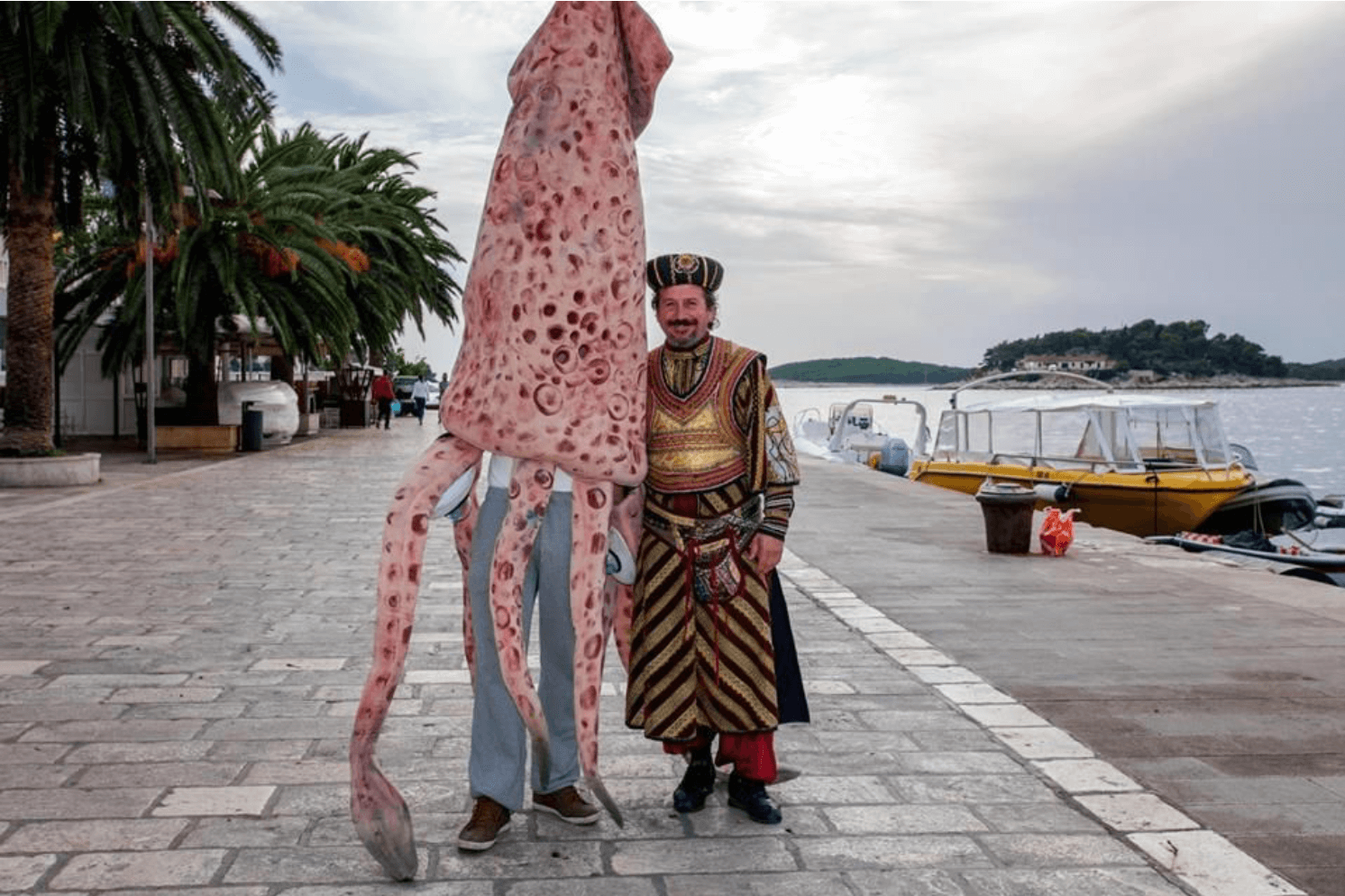
Squid fishing festival (Hvar)
As simple as that. Croatia has plenty of food festivals all year-round to celebrate delicious natural food. Some of these may sound silly, but we take our food festivals very seriously across the country. They vary from squid fishing in Hvar, Lavander festival in Hvar, Beans festival in north-eastern Croatia, to Chesnut and Paprika festival. In addition, there are lots more unique natural food festivals which you can explore to dive into the best of the best Croatia has to offer.
9. Hair drying rules
In Croatia, we take our hair drying rules very seriously because we are taught from a young age. You must always blow dry your hair, or you'll get sick, and when you do blow dry your hair, you have to wait at least an hour before going outside. Our parents and grandparents will probably get a heart attack if we leave the house with wet hair, even in the middle of summer. Also, you cannot be sitting next to an air conditioner or a window with your wet hair, it's just a big no from Croatian parents. Letting your hair dry naturally doesn't exist in Croatia and if you're brave enough to do it, prepare for some arguments with your Croatian friends and relatives.
10. The Dalmatian grunt
The way of greeting people across Dalmatia places is unique and confusing for both locals and tourists, known as the Dalmatian grunt. The greeting is very basic, and the same one can be used to say hi to a friend, give a compliment or even say bye. Mostly heard along with the Hvar dialect, the island people keep their vocabulary very simple; shouting "ee!" or "ej!" can mean many different things. Check it out in the video below.
Follow the latest on flights to Croatia HERE and the latest travel updates and COVID-19 news from Croatia HERE.
For more on travel in Croatia, follow TCN's dedicated page.
Find out more about Croatian food here HERE.
7 Reasons Why You Should Visit Iž Island
June 6, 2021 - Croatia is known as the "land of a thousand islands" and yet, only a handful are popular and visited by tourists. There are so many more islands to discover in Croatia, and one of them is the quaint but highly underrated Iž Island with only 500 inhabitants.
I found out about the island of Iž because my very first friend in Croatia who is now one of my best friends was born and raised there. I met her for the first time when we both attended a violin masterclass workshop in Kaštela and she asked me and my Croatian husband if we could drop her off at where she was temporarily staying in Split. On the car ride home, my husband asked her where her hometown is and she answered, "Iž". Judging by my husband's reaction, she easily sensed that he has never heard of this place before and so she explained further, "it is a small island near Zadar and it is not very known because there are only around 500 people who live there and there is fewer every year." From then on, I have always been fond of visiting the small islands in Croatia and learning about the islanders' unique way of life. Coming from the city of Manila (Philippines), which has a highly dense population of 24 million people, it was unimaginable for me to live on a small island where only a few hundred people reside; but after spending two blissful summers on Iž, it turned out that life on a quaint and unspoiled island is astonishingly delightful!
#1 - Enjoy summer without the hustle and bustle of tourists
Located within both the Zadar and Kornati archipelago, Iž is nestled between the islands of Ugljan and Dugi Otok and can be reached daily by catamaran and ferry from Zadar. Iž is surrounded by many islets and private beaches so it is an ideal destination for relaxing and tranquil getaways. The island is divided into two villages - Mali Iž and Veli Iž. In Veli Iž, you can find two shops, a couple of bars and taverns that open in summer, a small marina, and the church of St. Peter and Paul from the 14th century. Even in summer, the island doesn't get too crowded because most of the tourists go to nearby islands like Ugljan and Preko because they are closer to Zadar and are more accessible. Because of this, you can easily find a private corner by the sea on Iž and enjoy a quiet time for yourself. The island is also great for hiking because of the asphalt paths and roads that connect the whole island. To enjoy the views of this island, you can hike to the top of Korinjak which is the highest peak on Iž with a height of 168 meters. From that viewpoint, you can see the nearby islands such as Dugi Otok and Rava.
#2 - Vegetarian and vegan-friendly
In Veli Iž, you can find the Korinjak Hotel and Camp which is the only purely vegetarian hotel in the Dalmatian region. It offers Meditteranean-inspired vegetarian cuisine to its guest including raw food dishes, fruit and vegetable smoothies, gluten-free, lactose-free, and vegan meals. It is a popular destination for long-time vegetarians and to those who are looking to change their diet and detox their bodies through various holistic retreats and workshops that are conducted in this hotel every summer including meditation, relaxation therapies for mind-body energy, yoga classes, pyramid meditation and sound, and organ therapies. The hotel also offers excursions and boat trips to hidden bays and secluded nearby islets where visitors can enjoy their own private beach and islet for the day.
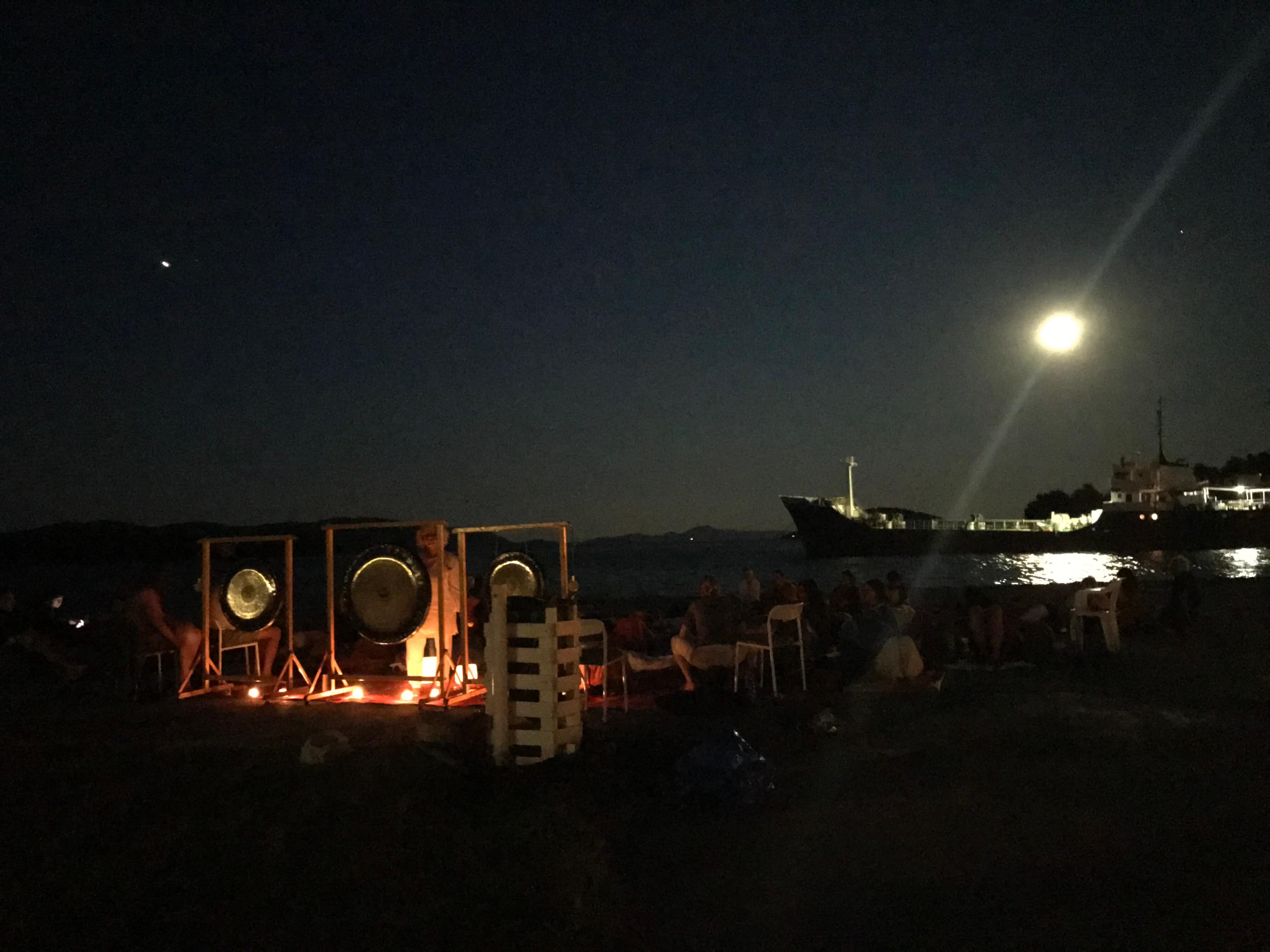
Moon gong retreat in Hotel Korinjak | Photo by: Kyla Ibero
#3 - Explore the island's rich and long history
The island of Iž has been inhabited since prehistoric times. Here, you can find traces of an Illyrian hillfort and Roma settlement. Previously named "Ez" by Emperor Constantine VII, the island was under the rule of the Zadar medieval commune but after a long feud, it was given to the Benedictine monastery of St. Mary and eventually ended up being owned by the Zadar aristocracy. Due to its long history, you can find architecture from as early as the 11th century such as the Church of St. Mary, located at the top of Mali Iž. Beside it stands a parish church which was constructed at the beginning of the 20th century. Records of the earliest Croatian settlers from the year 1266 can be found on this island, too. Iž also holds a thousand-year Glagolithic history. The parishes in both Veli and Mali Iž used to celebrate the earliest Roman Rites in the Old Church Slavonic Language, not in Latin, and based it on the liturgical books from the old Croatian Glagolitic scripts. The most recent discovery of a Glagolitic inscription was from this island at the family house of Švorinić and it was a Glagolitic inscription in stone that dates back from 1685. There are as well a lot of Glagolitic manuscripts, liturgical books, and stone epigraphs currently preserved in Iž.
#4 - Enjoy traditional pottery-making and local homemade products
The island of Iž has a long-standing culture of traditional pottery making. A special clay pot called "Iśki Lopiž" is only found on this island. This pot was traditionally used for storing olive oil and traditional kitchen condiments. It is also traditionally used for making stews on Iž because it adds a special and delicate flavour to the dish. In Veli Iž, you can find an ethnographic collection of traditional ceramics, tools, and pottery. The island is also famous for producing excellent quality olive oil, homemade vinegar, and natural soaps!
#6 - Join in the fun summer and winter events
During summer, a traditional game on Iž called "pošimpijada" is played by the locals. It is a fun competition between participants who live in the southern part of the island (team Jugo) and participants who live in the northwestern part of the island (team Zmorac). They compete in various games such as sack race, rope pulling, chess, and water basketball. Every July 29, Veli Iž celebrates Iška fešta where locals dress in traditional costumes, prepare local dishes, and perform old island dances and songs. During the festival, they also elect the King of Iž, Rava, and Lavdara. After the election, the fiesta would commence and popular singers like Oliver Dragojević, Giuliano, and Dino Dvornik would come and perform. Also during summer, a lot of concerts and theatre plays are conducted on the island. Since the winter of 2017, the island of Iž has been importing trucks of snow every winter from Lika and creates a small ski resort that has a length of 60-metres. This brings great joy to the locals during winter and few tourists who come to the island to ski.
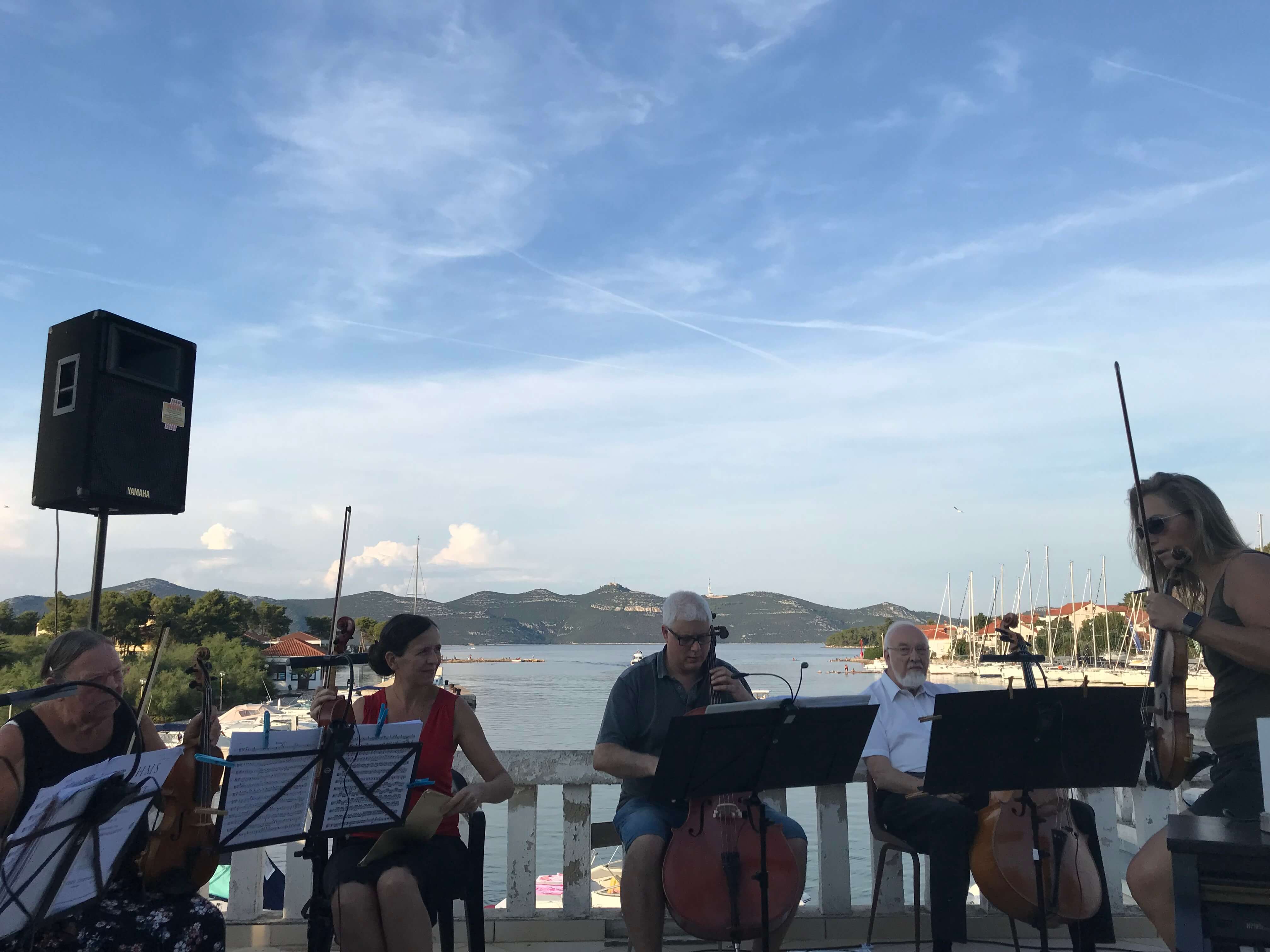
Outdoor summer concert in Iž with The Hague Chamber Orchestra | Photo by: Kyla Ibero
#7 - Authentic gastronomy
A lot of konobas and restaurants open on Iž for the summer. Since the island relies on both agriculture and fishing, the food is always offered fresh and of top quality. The cost of dining here is also relatively cheaper than other islands, for example, a plate of freshly-caught grilled seafood costs around 70HRK. The konobas and restaurants on this island all have their own special house wine. The traditional Dalmatian-cuisine which is called "brudet" is prepared on Iž with an added twist since they use their special traditional clay pot which is the "Iški Lopiž" and this heightens and elevates this dish to another level. CLICK HERE for the recipe of the traditional stew cooked in Iž using the special Iški Lopiž.
Life of a Local on Iž
My friend and a local of Iž, Tena Milinčić, shares with us the way of life in this small and secluded island because to spend a summer on Iž and to permanently live there are two completely different experiences.
Since there are only a few hundred people living on Iž, there are a few things that you cannot find on this island. First, there is no pharmacy - and the locals are kind of used to it. If they need to buy some medicine, they would have to take a ferry to Zadar or they would ask someone whom they know who is in Zadar to send it to them to Iž. There is a small ambulanta (clinic) on the island but it is not very well equipped. You cannot buy any medicine there and the doctor works only twice a week in Veli Iž and twice a week in Mali Iž.
There are also only 2 small shops on the island so the locals are accustomed to taking the ferry to Zadar to shop for their household needs and to get other services that are unavailable on the island such as printing services and hospital/clinical services.
The schools and students are slowly disappearing, too. Nowadays, on the island, there is only an elementary school up until the 8th grade. There are only around 8 students in the entire school. Not even a vrtić (kindergarten) is open because there are not enough kids on the island to attend it. This is really sad and unfortunate because there used to be a lot of educational establishments on the island especially during the war when a lot of people migrated to the island to avoid the conflict. For high school and university, locals leave the island and usually go to Zadar and other main cities in Croatia to continue their studies.
Life on this island can be sometimes idle, but in this place, you can find freedom and tranquility. The bond within the community is strong and the locals are friendly and helpful, too!
For more on lifestyle in Croatia, follow TCN's dedicated page.
For more about Croatia, CLICK HERE.
"Trust Me, I've Been There" Campaign Invites Guests to Spend Vacation in Croatia
ZAGREB, 19 May, 2021 - The Croatian National Tourist Board (HTZ) has launched its high-season promotional campaign "Trust me I've been there" across 12 key markets, the HTZ reported on Wednesday.
The campaign will be conducted in Germany, Slovenia, Austria, Italy, Poland, the United Kingdom, the Czech Republic, Hungary, France, the Netherlands, Slovakia and Russia until the end of July.
The HTZ says on its web site that the campaign is being "implemented through activities across social networks including Facebook, Instagram and YouTube, as well as via high-viewership TV channels, top-rated and most read portals and newspapers in each market and through outdoor advertising on billboards, digital panels and public transport."
"The goal of the campaign is to invite guests to spend their vacation in Croatia, as well as to further position our country as an attractive, safe and well-prepared destination," says the HTZ.
The HTZ director Kristjan Staničić was quoted as saying that this campaign "is different from all previous ones, i.e. that is personalized and adjusted to the preferences of each individual market."
"It is with this goal that we decided to create unique messaging, and the main faces of the campaign are satisfied guests who invite their fellow citizens to come to Croatia and shared first-hand information that our country is an ideal and safe destination for summer vacation," he explained.
For more news about lifestyle in Croatia, follow TCN's dedicated page.
For more news about Croatia, CLICK HERE.
OPG Čudesna šuma: Paradise Reimagined in Beautiful, Traditional Baranja
May 13, 2021 – OPG Čudesna šuma: How an unexpected turn of events helped world-renowned photographer Mario Romulić realise his lifelong dream.
War and genocide and the aftermath. Famine. Disease. Death. In a former life, harrowing images filled the lens of internationally renowned photographer Mario Romulić. But thankfully, we're now far from such scenes.
In fact, at OPG Čudesna šuma - Mario Romulić's home and family farm - we're pretty much far from everything. One other eco-farm is his only neighbour. Well, unless you count the llamas the Romulić family keep out back. Occasionally, through the rich green of surrounding trees, you see birds flying above the branches. Probably they're toing and froing from Kopački rit. The nearby Nature Park is less than a kilometre from OPG Čudesna šuma. Famously, the wetlands are home to over 250 species of birds. They are also the reason why Mario Romulić is here.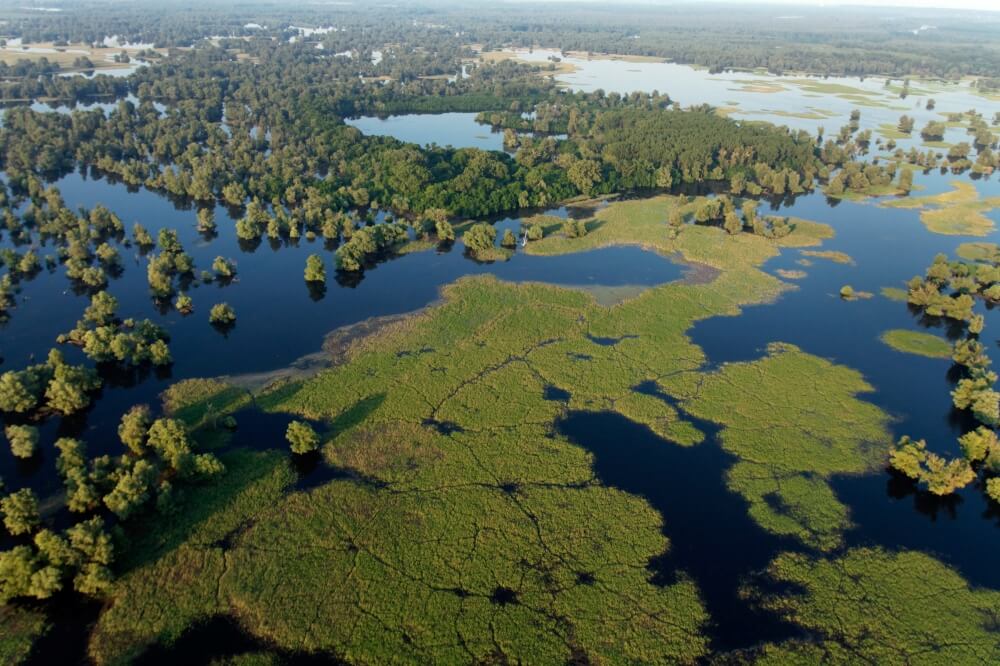 Kopački rit Nature Park © Kopački rit Nature Park.
Kopački rit Nature Park © Kopački rit Nature Park.
“Back then, I was very occupied with Kopački rit,” remembers Mario of the time, 21 years ago, when he moved to what is now OPG Čudesna šuma. “I was working as a cameraman for people like Reuters, all over the world. The assignments would last 7-10 days and I'd be in places like Afghanistan, Rwanda, Congo, Liberia, Bosnia. It was often quite dangerous. For the next 20 days, I would spend a lot of time in Kopački rit, trying to calm my nerves. It was something like a cure after seeing all these horrible scenes. Eventually, instead of travelling every day from my home in Osijek to Kopački rit, I decided to try and find something close by. And this is what I found.”
Just as this beautiful, natural landscape in Bilje, Baranja once served as a peaceful getaway for Mario Romulić, his OPG Čudesna šuma today does the same for others. Because, after dreaming for two decades of turning this blissful plot and homestead into a forest farm and eco-village, Mario Romulić is finally turning that vision into a reality.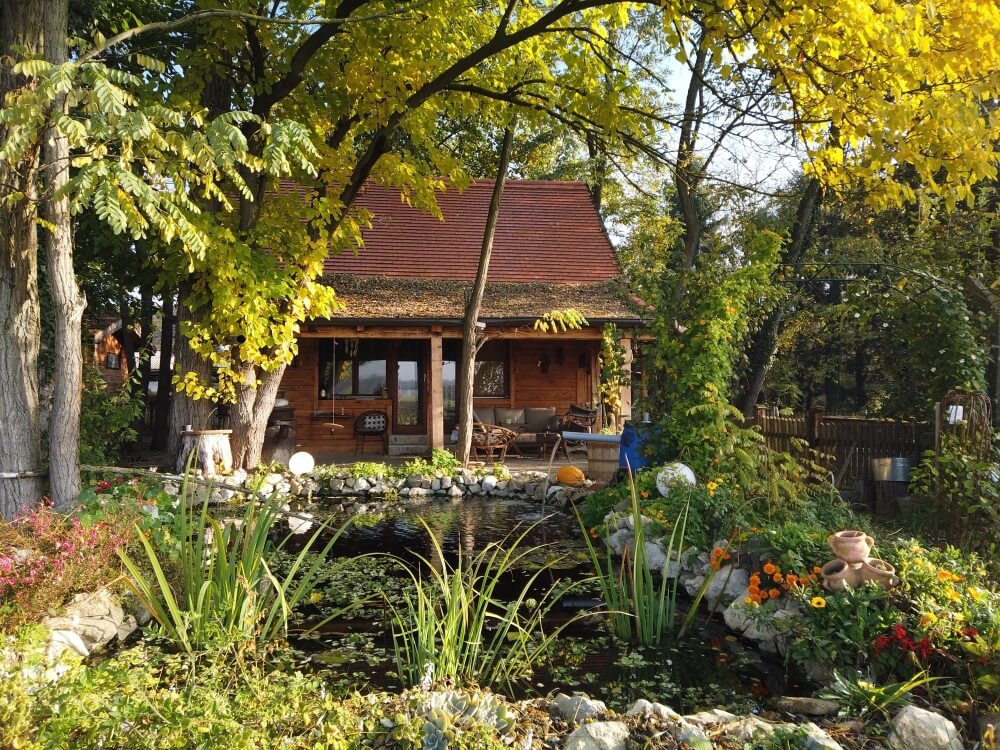 The impossibly pretty OPG Čudesna near Kopački rit Nature Park, Bilje Municipality, Baranja © OPG Čudesna šuma.
The impossibly pretty OPG Čudesna near Kopački rit Nature Park, Bilje Municipality, Baranja © OPG Čudesna šuma.
“Because of my job - first, travelling all around the world, then travelling Croatia - I did not even have much time to think about it, let alone do it,” says Mario. “But, then Corona came. Finally, I found myself at home. At last, I had time to work on my dream.”
OPG Čudesna šuma in the Month of Baranja Cooking (Mjesec baranjske kuhinje)
A group of 30 or so are Mario's guests today at OPG Čudesna šuma. They're here for a presentation of speciality cooking. It's the grand finale of the Month of Baranja Cooking (Mjesec baranjske kuhinje).
Over previous weeks, OPGs from all across the region have welcomed guests to try goulash, soups, stews, perklet and other traditional foods of the area. While visiting, they've been embraced by the beautiful landscape of Baranja. Not only have they discovered how this delightful, distinct cuisine tastes, but also they've learned exactly how it's prepared. However, they've evidently saved the best for last. On the menu today, river fish inventively cooked, accompanied by a riotous rainbow of seasonal vegetables. Seasonal vegetables of Baranja in springtime at the Month of Baranja Cooking (Mjesec baranjske kuhinje) © OPG Čudesna šuma.
Seasonal vegetables of Baranja in springtime at the Month of Baranja Cooking (Mjesec baranjske kuhinje) © OPG Čudesna šuma.
It's a beautifully sunny day, right at the start of May. It depends on your preference, but looking across this happy vista in the glorious sunshine, it's difficult to imagine this not being the perfect time to be in Baranja. Young children are raised to chest height by their parents so they can meet Mario's free-roaming llamas face-to-face. The children's faces flit between surprise, curiosity and delight. The llamas return their stare. They're used to welcoming new guests. Meeting the Romulić family llamas at OPG Čudesna šuma © Turistička zajednica Općine Bilje - Kopački rit.
Meeting the Romulić family llamas at OPG Čudesna šuma © Turistička zajednica Općine Bilje - Kopački rit.
Partially shaded by trees, the smiling adult guests sit casually on wooden benches around a central, outdoor cooking area. Several open fires display a range of traditional cooking methods. Steam rises from a cast-iron stove suspended over one. Beneath the vapours, you can make out the dish is fish paprikash. It's unmistakable because of the deeply red coloured bubbles, a result of generous amounts of paprika.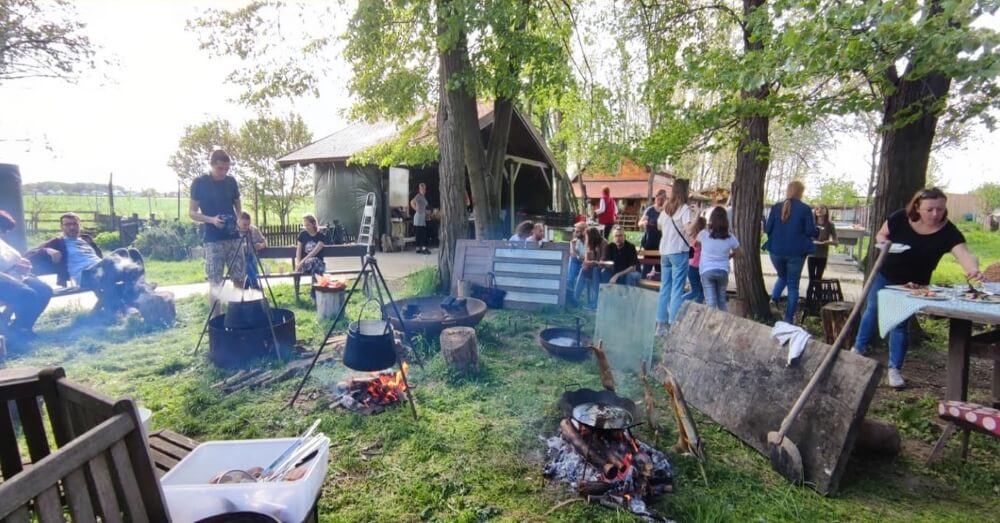 Guests enjoy a warm springtime day at OPG Čudesna šuma during the Month of Baranja Cooking (Mjesec baranjske kuhinje), as fish paprikas cooks over an open fire © OPG Čudesna šuma.
Guests enjoy a warm springtime day at OPG Čudesna šuma during the Month of Baranja Cooking (Mjesec baranjske kuhinje), as fish paprikas cooks over an open fire © OPG Čudesna šuma.
A huge bag of this paprika sits propped up, close by. It's from another organic OPG, just a kilometre or so from here. The colour is vivid, impossibly red, unrecognisable from anything store-bought. At the next fire, pike impaled on wooden sticks are placed far enough from the flickering flames so they cook slowly and do not burn.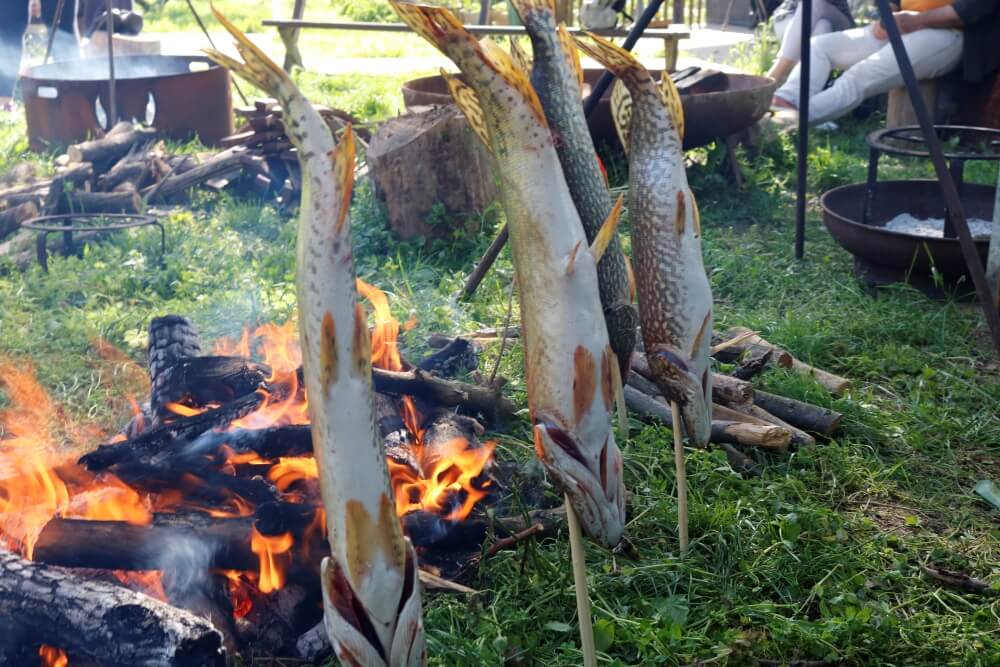 Pike impaled on sticks, cooking by an open fire at OPG Čudesna šuma @ Marc Rowlands.
Pike impaled on sticks, cooking by an open fire at OPG Čudesna šuma @ Marc Rowlands.
In the outdoor kitchen, Mario Romulić's co-chefs prepare an unending supply of fish dishes and vegetables. Carp, catfish, trout, bream. There's a bounty of fresh asparagus. It's that time of year. With the restraint of experience, they've cooked it perfectly. After the crunch of the bite, the flavour explodes. They're seasoned simply – delicious olive oil and sea salt.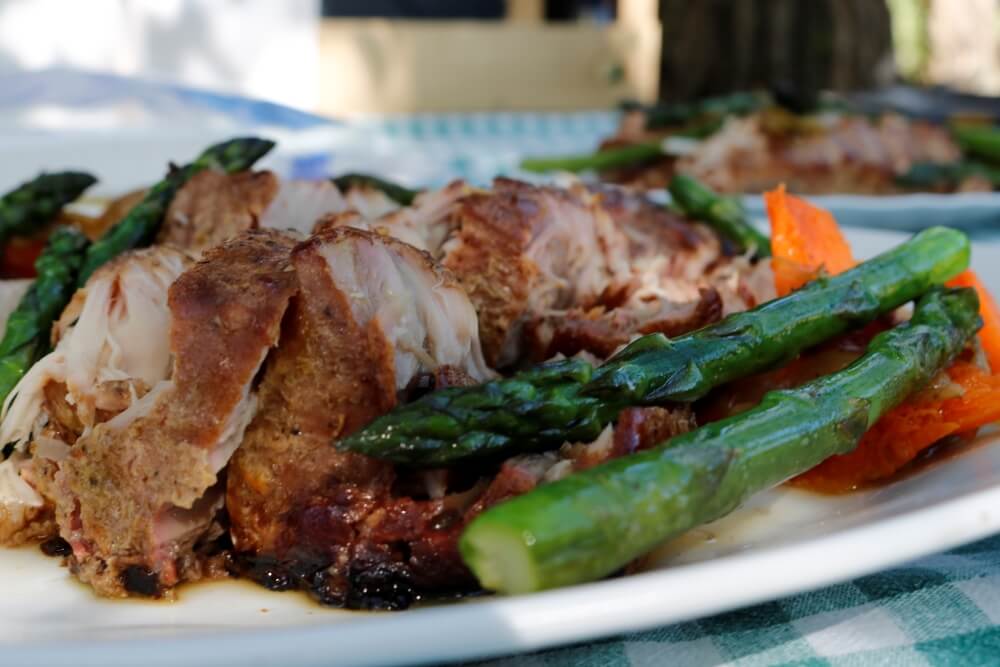 Seasonal asparagus, perfectly cooked, served with smoked river fish © Marc Rowlands.
Seasonal asparagus, perfectly cooked, served with smoked river fish © Marc Rowlands.
A group of peers – accomplished chefs from Osijek-Baranja restaurants – peak over the shoulders of Romulić's co-chefs. They're admiring the inventive techniques employed. Although, being chefs, they can't help themselves. They end up briefly forgetting their families in order to help out.
Mario Romulić, the host with the most
 Mario Romulić © Turistička zajednica Općine Bilje - Kopački rit.
Mario Romulić © Turistička zajednica Općine Bilje - Kopački rit.
After all the guests arrive, Mario Romulić holds court. Cheerily he welcomes us all to OPG Čudesna šuma and the event. Without question, the success of rural, village tourism depends on the personalities of the hosts. It's no good plonking a group of visitors in a pretty place and throwing some food in front of them. We've all seen trees, grass and food before. Rural tourism is not just about the place, it's about the experience, the ambience. And, especially, it's about the people.
Hands down, the OPGs of Slavonia and Baranja are the best in Croatia at this. The folks here are famous for their friendliness, warm welcome and big personalities. And, Mario Romulić has one of the biggest of them all.
In the research for this reportage, looking back at archive pictures of Mario Romulić is startling. During his years spent as an international photographer, he himself has been photographed many times – on assignment in distant countries, at the opening of exhibitions that have showcased his celebrated work. In most, there's an intensity to his stare. It's sometimes difficult to look at. He looks like a man who has tales you never want to hear, like a man who has seen too much.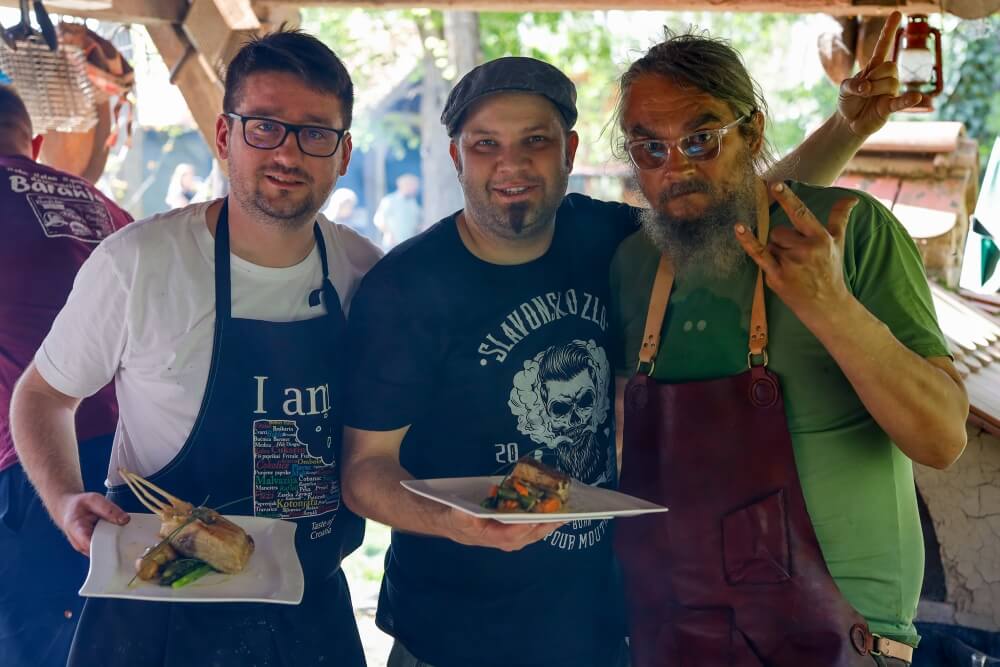 (L- R) OPG Čudesna šuma co-chef at the event Mihael Tomić, renowned Osijek chef Ivan Đukić currently of Osijek's Lipov Hlad and a happy Mario Romulić © Turistička zajednica Općine Bilje - Kopački rit.
(L- R) OPG Čudesna šuma co-chef at the event Mihael Tomić, renowned Osijek chef Ivan Đukić currently of Osijek's Lipov Hlad and a happy Mario Romulić © Turistička zajednica Općine Bilje - Kopački rit.
By comparison, the Mario Romulić that welcomes us at OPG Čudesna šuma today is unrecognisable. Sure, there's a little more grey to his long hair and beard but, otherwise, he looks incredibly healthy and happy. The intense stare is gone, replaced by a warm, wide smile that shows across his entire face. Even in early May, he has a darkened skin tone, the telltale signs of a man who spends much of the day outdoors. Romulić's enthusiasm for his guests and the event is palpable. After his sincere welcome, this enthusiasm is immediately transferred to each of his guests.
Mrs Romulić ensures everyone's glass is overflowing with wine or juice. One of Mario's teenage sons helps out with the food, while the other is taking photographs of the event. Well, someone has to do the photography now that dad wants to be a chef and host! Mario himself is engulfed in smoke. Among the other duties he's assumed today, Mario is tending a smoker. Without a doubt, this is the most revelatory cooking method we meet today.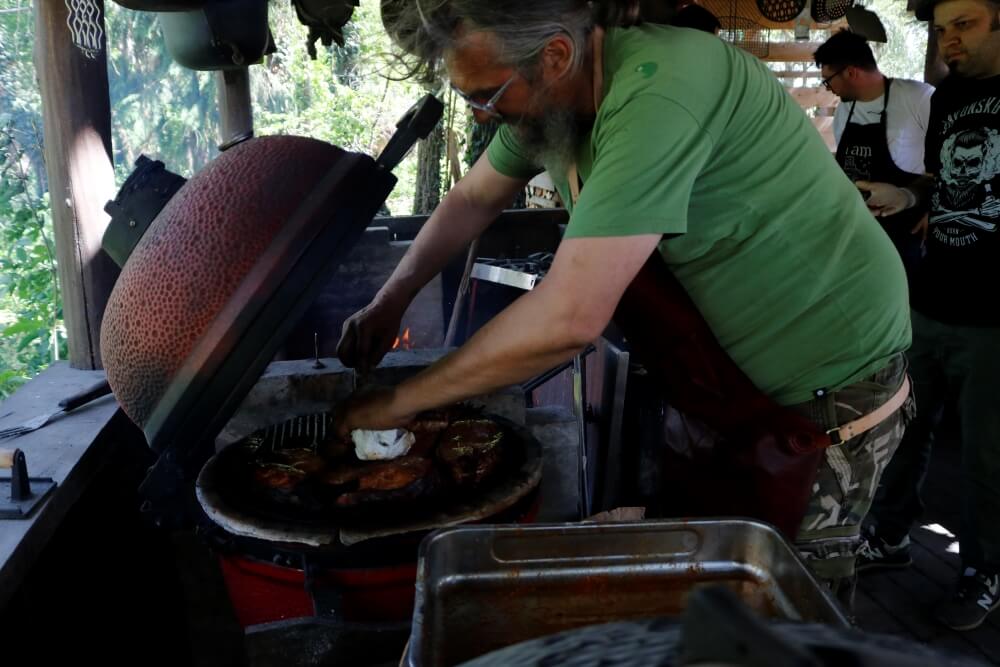 Mario Romulić tends to smoked river fish, a revelatory gastronomic experience at OPG Čudesna šuma © Marc Rowlands.
Mario Romulić tends to smoked river fish, a revelatory gastronomic experience at OPG Čudesna šuma © Marc Rowlands.
Smoked fish of Slavonia and Baranja at OPG Čudesna šuma
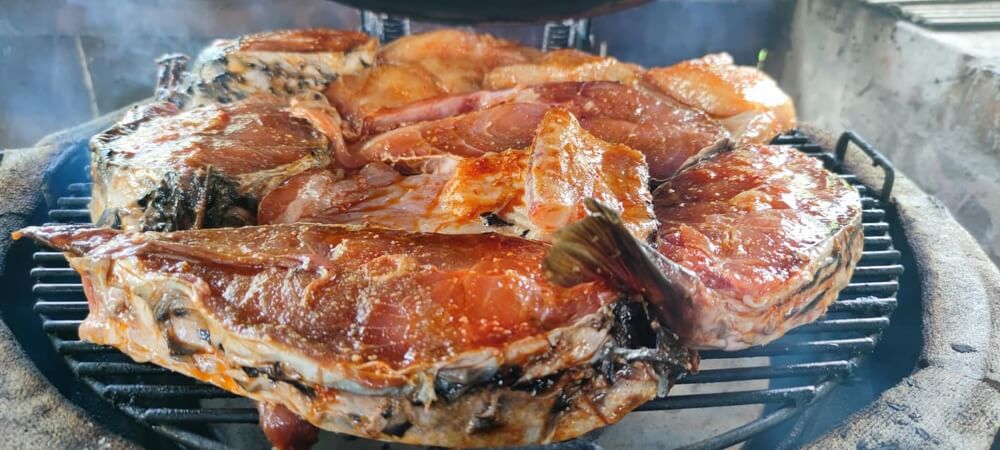 An American-style smoker, loaded with river fish. TOP TIP: A great way to stop fish sticking to the grill of your barbecue or smoker is to place them on top of a layer of lemon slices © OPG Čudesna šuma.
An American-style smoker, loaded with river fish. TOP TIP: A great way to stop fish sticking to the grill of your barbecue or smoker is to place them on top of a layer of lemon slices © OPG Čudesna šuma.
“We do have smoked fish here, but not in this way,” he says. “This is more like an American grill. I never heard of anyone trying Baranja cooking like this. Actually, I never heard of anyone nearby who has a smoker like this. The first time I tried stuka (pike) in the smoker, that was unbelievable. It's incomparable, really special.” Exquisite presentation of river fish by the enthusiastic team of OPG Čudesna šuma © Turistička zajednica Općine Bilje - Kopački rit.
Exquisite presentation of river fish by the enthusiastic team of OPG Čudesna šuma © Turistička zajednica Općine Bilje - Kopački rit.
“In Slavonia and Baranja, there are just a few ways we usually cook our river fish - carp on sticks, fish paprikash, perklet and fried fish. So, we tried something new, to expand the palette. For instance, almost nobody eats Babuška (a type of carp). They feed it instead to their pigs. It costs 5 kuna a kilo! But, if you cook it in this completely natural way, it's delicious.”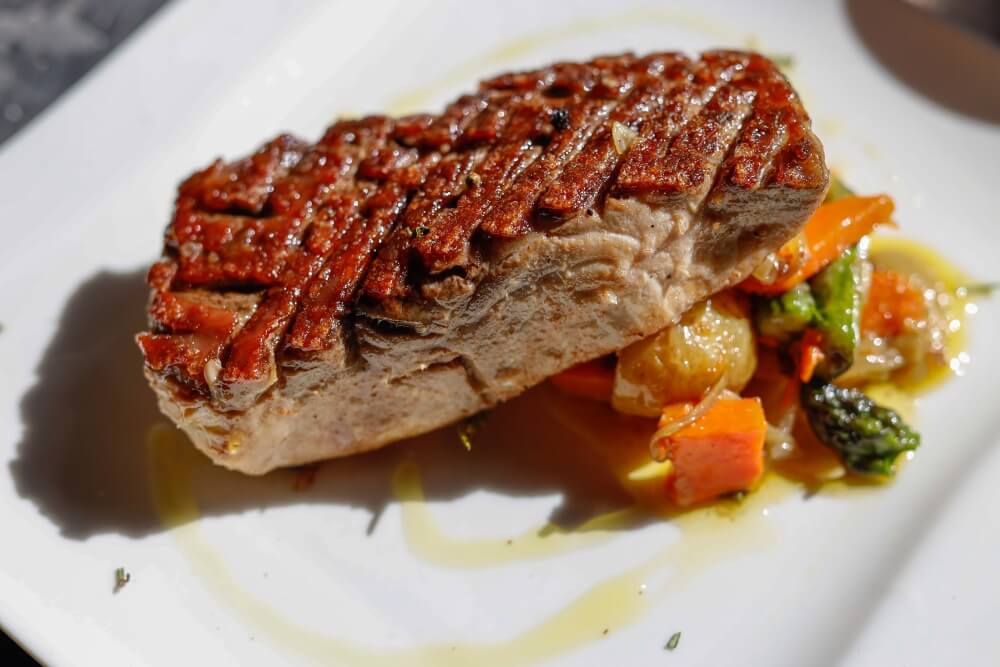 More river fish, cooked by the team of OPG Čudesna šuma © Turistička zajednica Općine Bilje - Kopački rit.
More river fish, cooked by the team of OPG Čudesna šuma © Turistička zajednica Općine Bilje - Kopački rit.
He's not wrong. Today's mountain of different smoked fish is the talk on most of the adult lips. The rich flavours surprise. Compliments and returns for second helpings ensue. Mario stands to one side, happily watching as his smoked fish secret escapes. In the future, he plans similar events based on other regional foods - Black Slavonian pig, wild meats like deer or boar. Eventually, in the seven hectares of land he owns here, he would like to expand OPG Čudesna šuma as an eco-village, with beds for visitors, a natural swimming pool and then surround it with a food forest. Big plans. It looks as though the camera may stay more permanently in the hands of his son. Because it's difficult to imagine Mario Romulić leaving his happy place and the realisation of his long-held dream. Mario Romulić in his happy place, with a friend © OPG Čudesna šuma.
Mario Romulić in his happy place, with a friend © OPG Čudesna šuma.
Both the author and Total Croatia News would like to thank the following for their invaluable help in creating this article: Ivana Jurić and the Tourist Board of Osijek-Baranja County, OPG Čudesna šuma, Mario Romulić and family, Renata Forjan and Turistička zajednica Općine Bilje - Kopački rit and Domagoj Butković of expert travel guides to Slavonia and Baranja, Kulen travel.
Krka National Park Ticket Discount: Walk for a 20% Cheaper Visit in May
April 30, 2021 - Throughout the month of May, a Krka National Park ticket discount is going to be offered in the Park's "Go and Walk" action, which provides a 20% cheaper ticket to any visitor ready to enter and exit the premises on foot.
Krka National Park, as stated on their website, is going to be inviting visitors to enter the Park on foot and get a 20 percent discount on their individual ticket price for doing so. This offer is part of the ''Go and Walk'' action, which starts on Saturday, May the 1st, and is set to continue throughout the whole month.
''The ''Go and Walk'' promotional action implies that people must enter and exit the park on foot in order to get the Krka National Park ticket discount of 20%. All of the park's other services, as well as tickets for visitors who will enter the park by boat or a bus, will be charged by as normal,'' according to Krka National Park's official website.
The discount varies pending on where you intend to go. If you decide to go to the main spectacle of the park, The Skradinski Buk waterfall by taking the hitchhiker trail, either from Lozovac or Skradinski Bridge, the promotional price is 80 kuna. Apart from Skradinski Buk, all other land localities in the park are set to be included in that price. Kids aged 7-18 accompanied by parents or guardians will have to pay only 64 kuna for their ticket, while for kids up to the age of 7, entrance to the park is free of charge.
If you decide to walk only until Roski Slap, an adult ticket will cost 40 kunas and for kids (7-18-year-olds), only 32 kuna.
The third option is also the Krka Monastary and Burnum archaeological site. An adult ticket price for that path is 32 kuna, while the children's ticket costs a mere 24 kuna.
''With the ''Go and Walk'' action, the Public Institute of Krka National Park wants to encourage the active visiting of the park, and the usage of educational-hitchhiking trails too, by reducing the usage of public transport by bus and boats and having a direct impact on lowering CO2 emissions,'' said Nella Slavica of the Public Institute of Krka National Park.
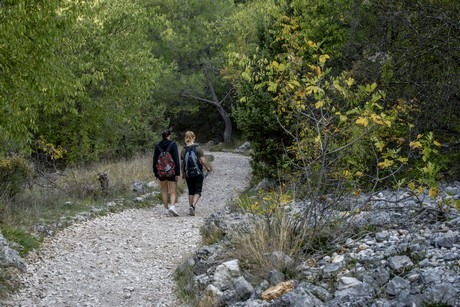
© Krka National Park
Krka National Park is also a holder of the ''Stay Safe in Croatia'' badge, and the park is being very careful in ensuring epidemical measures are respected by both the visitors and employees while informing the public about the benefits of being out in the open air during these challenging times.
Back in the former Yugoslavia, on January the 24th, 1985, the Parliament of the Socialist Republic of Croatia declared Krka a National Park, and it has enjoyed an enormous amount of popularity ever since. This gorgeous park remains a place of natural and cultural heritage, a place to learn, a place to rest, and a place to enjoy a lovely escape from the stress of modern life.
Learn more about Krka National Park on our TC page.
For more about travel in Croatia, follow TCN's dedicated page.
Reuters Reporters Visited Plava Laguna Parentium Hotel in Poreč: "Good Tourist Season Coming"
April 24, 2021 - Reuters reporters visited Plava Laguna Parentium Hotel in Poreč and seemed happy with preparations for the upcoming tourist season.
International media praise Croatia as a lovely holiday spot, and many foreign reporters visited Croatia to check the field with their own eyes. And 2021 is no different.
As Istria Terra Magica reports, journalists from Reuters visited Parentium Hotel, a member of Plava Laguna Hotel Group.
„Reuters reports that Poreč streets are empty for now, but thanks to measures to keep tourists and tourist workers COVID-free, a good tourist season is in preparation“, says Istria Terra Magica.
The site adds that in the following weeks 80,000 tourist workers are planning to be vaccinated, and Covid-19 tests will be offered to the guests as well.
The full article about visiting Croatia is available on the Reuters website.
Dnevno.hr covered the story too and added that „Reuters is a news agency spawned across 200 locations worldwide, and a synonym for independence and integrity“.
Plava Laguna hotel group is one of the most influential accommodation companies in Istria, with four resorts, 25 hotels, and 13 apartments across Umag, Poreč, and Rijeka.
„At Plava Laguna, everyone is welcome. From the moment they arrive to the moment they leave, we want our guests to feel the warmth of our hospitality. So we introduce them to our beautiful Istrian countryside and the wonderful Adriatic sea. We share the delights of our national cuisine and fantastic wines. We show our guests the best of Croatia“, says their official website, available in Croatian, English, German, Slovenian, and Italian language.
The website also concludes that regardless of staying in a two-star or a five-star hotel, every visitor is considered a VIP guest.
Learn more about Poreč on our TC page.
For more about travel in Croatia, follow TCN's dedicated page.


